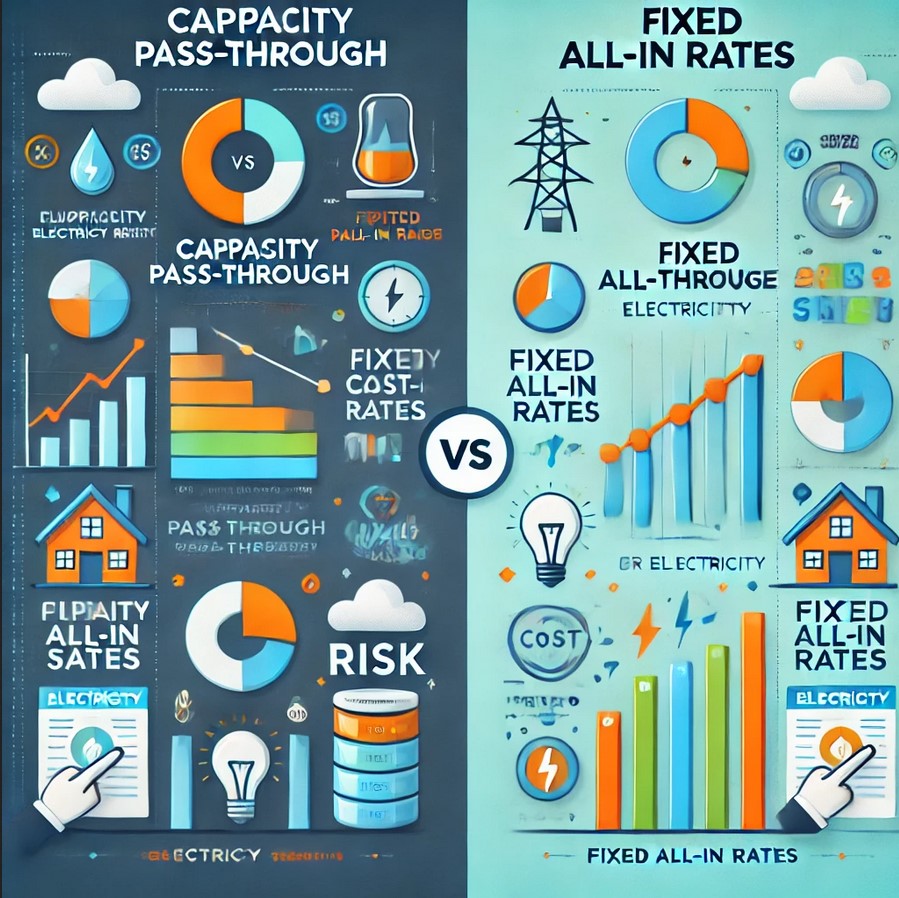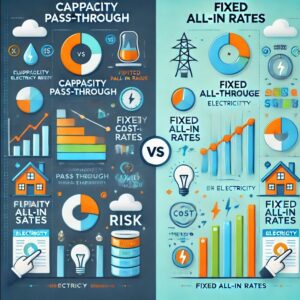Capacity Pass-Through versus Fixed All-In Electricity Rates

Difference and Benefits of Capacity Pass-Through vs. Fixed All-In Rates for Electricity
When it comes to electricity pricing, businesses have a choice between two primary types of rate structures: Capacity Pass-Through and Fixed All-In Rates. Understanding the difference between these options is essential for making informed decisions about energy procurement, as each has its unique benefits depending on your business needs and risk tolerance.
What is Capacity Pass-Through?
Capacity Pass-Through is a pricing model where the cost of capacity (which is the price charged to ensure that there is enough generation available to meet peak demand) is separated from the energy supply rate and passed directly to the customer. Essentially, the capacity cost is not included in the energy rate but is instead billed as a separate charge based on actual market conditions.
How Does Capacity Pass-Through Work?
In this model, customers are billed based on their share of the system’s peak demand (also known as the “coincident peak”). The cost fluctuates with market prices, so the amount your business pays may vary depending on demand spikes and market changes. Capacity charges can account for a significant portion of the electricity bill, especially during high-demand periods such as hot summer days or during times of increased energy consumption.
What is a Fixed All-In Rate?
Fixed All-In Rate refers to a pricing model where all components of your electricity costs—energy supply, capacity, transmission, and other associated fees—are bundled into one fixed rate. This rate remains the same over the duration of the contract, regardless of market fluctuations or changes in capacity costs.
How Does a Fixed All-In Rate Work?
With a fixed all-in rate, businesses pay a set price per kilowatt-hour (kWh) throughout their contract term, providing predictability in energy costs. This model insulates businesses from the volatility of electricity markets and capacity charges, making it easier to manage budgeting and long-term planning.
Key Differences Between Capacity Pass-Through and Fixed All-In Rates
| Feature | Capacity Pass-Through | Fixed All-In Rate |
|---|---|---|
| Price Volatility | Subject to market fluctuations, especially during peak demand periods | Fixed rate, unaffected by market conditions or capacity changes |
| Risk Level | Higher risk due to the possibility of price spikes | Lower risk with predictable costs throughout the contract |
| Budgeting | Harder to budget, as costs may vary month-to-month | Easier to budget with consistent monthly costs |
| Market Sensitivity | Exposed to real-time market and capacity pricing | Insulated from market pricing changes |
| Potential Savings | May save during low-demand periods if prices decrease | Locked into a rate that may be higher than the market during low demand |
| Complexity | Requires more active management and understanding of market trends | Simple and straightforward, no need for constant market monitoring |
| Who It Benefits | Best for businesses that can manage their demand or operate during off-peak times | Best for businesses looking for price stability and budget certainty |

Benefits of Capacity Pass-Through
- Potential for Lower Costs
- Seasonal and Market Opportunities: During periods of low demand or favorable market conditions, businesses may pay less for capacity charges. This can result in savings over time if the market prices decrease or if your business operates outside of peak hours.
- Tailored Cost Control: Businesses that can shift energy use to off-peak times or manage their demand profile may benefit by reducing their share of the system's capacity costs.
- Market Transparency
- Direct Exposure to Market Prices: This model gives businesses visibility into actual market costs for capacity and electricity. If market prices decrease, businesses directly benefit from these reductions without having to renegotiate their energy contracts.
- Flexible Contracts
- Adapt to Market Conditions: If you have the ability to monitor energy markets, Capacity Pass-Through gives you the flexibility to take advantage of favorable market conditions, while avoiding being locked into a potentially high fixed rate during times of market downturns.
- Reduced Premiums
- Fixed-rate contracts often have a premium built into them to account for the supplier’s risk of market volatility. By opting for Capacity Pass-Through, businesses avoid paying this premium.
Benefits of Fixed All-In Rates
- Budget Certainty
- Predictable Energy Costs: Fixed all-in rates provide businesses with a clear and predictable energy cost. This makes it easier for businesses to budget and forecast their energy expenditures, without worrying about unexpected price spikes or capacity cost increases.
- Stability in Energy Planning: Businesses that value stable, consistent pricing for long-term planning find this model more suitable because it shields them from the uncertainties of the energy market.
- Lower Risk
- Protection from Market Volatility: By locking in a fixed rate, businesses are protected from energy price volatility and potential market disruptions. Even if capacity costs rise or the electricity market experiences price hikes, your business is unaffected and continues paying the same rate.
- Ideal for Risk-Averse Businesses: Businesses that cannot afford the risk of sudden increases in their electricity costs, or those that have limited flexibility in their energy usage patterns, benefit from the fixed all-in rate.
- Simplified Management
- No Need to Monitor Markets: With a fixed all-in rate, businesses do not need to actively monitor energy market trends or worry about changing market conditions. This makes energy procurement and management much simpler, reducing the need for in-depth energy market expertise.
- Protection from Peak Demand Spikes
- Capacity Charges Covered: Fixed all-in rates include capacity charges, insulating businesses from potential cost increases due to peak demand. This is especially beneficial during seasons of high electricity usage when market prices can soar.
Which Rate Structure is Best for Your Business?
The choice between Capacity Pass-Through and Fixed All-In Rates depends on several factors, including your business's risk tolerance, energy consumption patterns, and market knowledge. Here are a few considerations to help you decide:
- Risk Tolerance:
- If your business is risk-averse and prioritizes budget stability, a Fixed All-In Rate is likely the best option.
- If your business can tolerate some level of price fluctuation and wants to potentially capitalize on lower market prices, a Capacity Pass-Through model may provide more financial benefits.
- Energy Consumption Patterns:
- Businesses with the flexibility to adjust energy usage to off-peak times or reduce overall demand during peak periods may benefit from the Capacity Pass-Through model.
- Businesses with consistent, high energy usage or those operating during peak times may prefer the Fixed All-In Rate to avoid unpredictable costs.
- Market Expertise:
- If your business has the resources to monitor and react to market conditions, Capacity Pass-Through may offer opportunities to lower costs. However, it requires active management and understanding of energy markets.
- For businesses without dedicated energy management expertise, Fixed All-In Rates provide a simpler and more straightforward option.
Today both Capacity Pass-Through and Fixed All-In Rates have distinct advantages, and the right choice depends on your business's unique needs and goals. Capacity Pass-Through offers flexibility and the potential for cost savings during low-demand periods but comes with more risk due to market price volatility. On the other hand, Fixed All-In Rates provide stability and simplicity, making them ideal for businesses that prefer budget certainty and lower risk.
